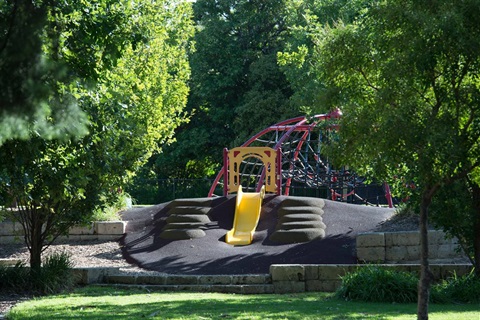Playground Strategy

This is the first Playground Strategy developed for the City of Burnside. This Strategy takes the approach that open space planning for children's use should be aimed at providing:
A wide range of safe fun and stimulating playspaces meeting the needs of local children, (as well as the wider population) and complementing the play opportunities available to them in their everyday lives.
Playgrounds play an important role in the development of children through the provision of experiences that may not otherwise be available in their everyday life. Obvious benefits include a range of physical development such as improved coordination, balance and spatial awareness. Indirect benefits cover a wide range of social, cognitive and creative qualities that are very important on the development of the 'whole' person.
The City of Burnside currently has 35 Council owned and managed playgrounds. The quality of these playgrounds varies considerably throughout the city. A number of challenges face Council to ensure that provision of playgrounds is appropriate for current and projected communities and their needs. Expectations change over time and residents don't necessarily need to be able to walk to a local playground. The playgrounds they use need to be safe, accessible, exciting and fun, with additional elements including shade, seating and in some cases, fencing.
The Strategy focuses on the play needs of children (0-12 years) and the subsequent needs of their parents and caregivers when visiting playgrounds. The Strategy does not examine in detail the provision of facilities for young people, such as skate parks. It does however, acknowledge that young people over the age of 12 visit playgrounds and look for play opportunities to be challenged.
Council is faced with the challenge of upgrading and developing all playgrounds throughout the city to a high standard that offer various experiences at individual playgrounds. This document is intended to guide Council in determining to what extent a playground may be developed, what priority is the playground to be developed for whom they cater, and what additional infrastructure is appropriate.
The Playground Strategy will assist the City of Burnside to increase the potential of its playgrounds and broaden play opportunities over the next 10 years.
Playgrounds throughout the city have been classified into three distinct categories, each designed to meet the criteria outlined and that of the play value rating system appropriate to subject age groups. These categories are: Regional Playgrounds, Neighbourhood Playgrounds and Local Playgrounds.
Other issues addressed in the Strategy include risk management; shade, access and equity; community involvement; play/sport association; upgrading; maintenance; budget allocation; and marketing and promotion.
A series of 22 principles are detailed throughout the Strategy. These principles are categorised into either Play Context, Play Provision, or Play Management.
All the directions in the Strategy are important as they improve the quality, safety, appealand value of playgrounds across the city. However, Council will not have the resources to undertake all improvements immediately and a priority listing will assist to plan budget allocation over time. The Playground Strategy could require 10 years or longer to fully implement, at which time many playgrounds will require upgrading again.